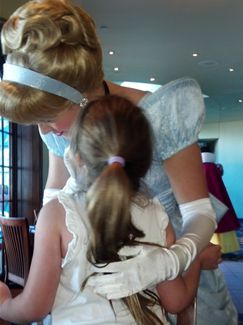Learning from the Legend
 During the 2012 Annual ALA conference in Anaheim, three librarians from Colorado attended an all-day pre-conference at the Disney Institute, organized by ALA’s Learning Round Table. Through their panel presentations in the webinar, What Would Walt Do?: Quality Customer Service for Libraries, Crystal Schimpf, Program Manager at the Community Technology Network, Elena Rosenfeld, Associate Director of Public Service at High Plains Library District, and Suzanne McGowan, Branch Manager at Anythink Wright Farms each confirm that the take-aways from Disney’s Quality Service training is not only relevant for today, but relevant for today’s libraries.
During the 2012 Annual ALA conference in Anaheim, three librarians from Colorado attended an all-day pre-conference at the Disney Institute, organized by ALA’s Learning Round Table. Through their panel presentations in the webinar, What Would Walt Do?: Quality Customer Service for Libraries, Crystal Schimpf, Program Manager at the Community Technology Network, Elena Rosenfeld, Associate Director of Public Service at High Plains Library District, and Suzanne McGowan, Branch Manager at Anythink Wright Farms each confirm that the take-aways from Disney’s Quality Service training is not only relevant for today, but relevant for today’s libraries.
The ethos behind the Disney customer service model is that we can provide exceptional customer service by establishing a process that empowers staff to infuse their work with their own personal sense of purpose. In libraries we can retool this model so that every staff member is prepared and empowered to interact with our patrons in their own way, making their interactions with each patron genuine.
 Walt Disney stated, “We have always tried to be guided by the basic idea that, in the discovery of knowledge, there is great entertainment—as, conversely in all good entertainment there is always some grain of wisdom, humanity, or enlightenment to be gained.” It is amazing to think that a customer service model, established so many years ago, can still resonate so profoundly with us today. Two topics stood out through the webinar, eliciting a wide range of responses from the over 500 webinar attendees.
Walt Disney stated, “We have always tried to be guided by the basic idea that, in the discovery of knowledge, there is great entertainment—as, conversely in all good entertainment there is always some grain of wisdom, humanity, or enlightenment to be gained.” It is amazing to think that a customer service model, established so many years ago, can still resonate so profoundly with us today. Two topics stood out through the webinar, eliciting a wide range of responses from the over 500 webinar attendees.
1. Why should safety be our first priority? Safety is Disney’s first priority to their customers, followed by courtesy, show and efficiency. Their thinking is that if people are not safe, they will not come back, thus making the other priorities moot. This sparked much discussion from panelists and participants—and in light of the recent tragedy in Newtown, CT, seems particularly poignant to consider our responsibility to provide a safe public institution to our community. Below are participant and panelist comments. What do you think?
• Not for me. I want efficiency first and foremost. Then courtesy. Fortunately, I live in a small town where safety is a given.
• Disney can afford safety at a level that libraries cannot.
• Safety doesn't necessarily cost a lot of money.
• Libraries will inconvenience patrons regularly for safety.
• Safety is an attitude that you can teach at the institutional level.
• Yes, lack of safety is extremely expensive
• Simple as making sure your book trucks are out of the way so no one can fall on them
• You need to build safety into your design.
• One big safety issue can be the other patrons...
• Lack of safety is demoralizing, too. No one wants to feel threatened or unsafe.
• start small and be aware of surroundings
• Safety is not necessarily the same as security.
• Safety is expensive
• I recommend the book/presentation Black Belt Librarians for a resource to help make safety choices that are cost free
• Roving is a great way to stay aware and be politely inhospitable to bad behavior.
• Safety is Teamwork
• Trust me on this...not having proper safeguards is more expensive in the end. Much of this is not expensive, but looking at potential problems and fixing it
• Part of the "safe" space is being welcoming and keeping it safe emotionally as well.
• We are located in a rural community and one of the things that has helped the most as it relates to safety is a good report with the police department.
• Our safety at a library may look different from Disney’s: it involves good collaboration w/police department; training for staff; how we align our services, building layout, process so that safety is front of mind
• Essential for public facilities to provide safe spaces for our community—both in the physical space and a safe space for people to grow & learn
 2. How do we continue to provide genuine, authentic responses to our patrons? Working with the public in a library means that we occasionally get the great, juicy reference question, and often get the same, seemingly obvious, questions—over and over. At Disney, they refer to it as the “When is the 7 o’clock light show” question. But what are people really asking? For the light show question, they might really be asking: “When should I start lining up?” Or, “What should I do to get the best experience?” It’s easy to begin thinking, “What a stupid question!” And while we don’t say that out loud, our body language may still convey what we’re thinking. But if we are getting the same question all the time, the answer must not be as obvious as we think it is, and our patrons might be asking something less direct. Here’s what participants had to say about keeping interactions with patrons authentic:
2. How do we continue to provide genuine, authentic responses to our patrons? Working with the public in a library means that we occasionally get the great, juicy reference question, and often get the same, seemingly obvious, questions—over and over. At Disney, they refer to it as the “When is the 7 o’clock light show” question. But what are people really asking? For the light show question, they might really be asking: “When should I start lining up?” Or, “What should I do to get the best experience?” It’s easy to begin thinking, “What a stupid question!” And while we don’t say that out loud, our body language may still convey what we’re thinking. But if we are getting the same question all the time, the answer must not be as obvious as we think it is, and our patrons might be asking something less direct. Here’s what participants had to say about keeping interactions with patrons authentic:
• If you want to ruin someone's library experience and possibly hurt your library's reputation, make someone feel stupid for asking a question.
• Respond to common questions with a genuine smile
• Smile!
• I deal with one customer at a time.
• Train your staff well
• Treat them as if it is their first visit to the library
• I think of new ways to great conversation starters
• I love what I do.
• Smiling it is free
• Put yourself in the patron's place every time.
• I try to remember the patron who always visit and ask them how they are doing
• minimize consecutive desk hours
• Eye contact is very important
• Greet everyone
• When I help a patron I pretend I'm helping my grandmother!
• By encouraging my staff and empowering them
• Build empathy into staff by surrounding them with support & authenticity
• Nod in agreement---you HEAR them.
• Be in the moment
• Ask ‘How can I help you?’
• Smile in person AND on the phone
• Laugh...with each other, with our patrons, just keep smiling.
• Use patrons name, if you know it
• Displays tied in to programs; frequently changed displays
• Updated signs and posters
• Invite patrons to programs happening at the moment
• I try to remember that even though I've heard the question a thousand times and the patron has prefaced it with a "this might be a stupid question" that it's their first time asking the question and they deserve a fresh and genuine response.
• Often students will apologize for what they consider "bothering" me. I respond with "please bother me". It's job security.
• I just had a fresh thought - I need to treat not just patrons - but ALL my co-workers with Disney customer service.
• Each person each time depends on each one of us
To get more tips for applying Disney customer service techniques to your library and learn the many on-the-ground techniques shared by attendees, watch an archive of the webinar and view the related resources.
[Images: Our presenters from left to right: Elena Rosenfeld, Crystal Schimpf and Suzanne McGowan; Flickr photo courtesy of Brian G. Wilson; Suzanne's daughter with Cinderella.]
